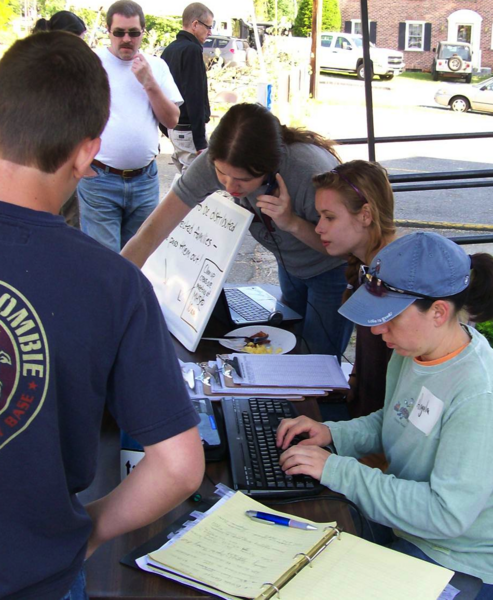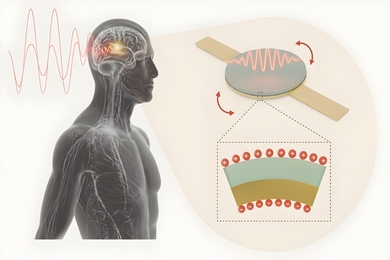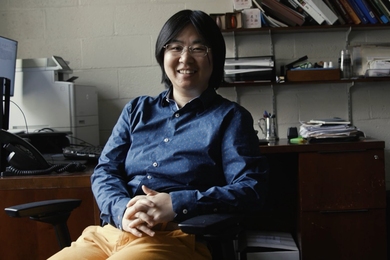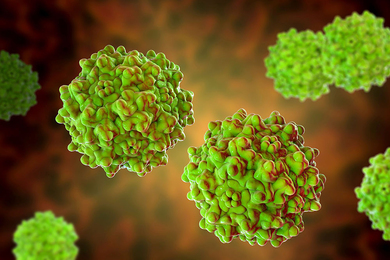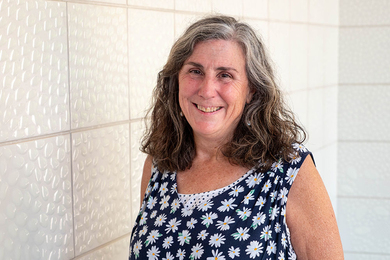As part of the MIT IDEAS Global Challenge, dozens of student-led teams are inventing and innovating solutions to critical quality-of-life barriers around the world. In this series, we learn more about individual teams’ efforts to develop solutions that could earn them seed grants of up to $10,000 at the IDEAS Global Challenge awards ceremony on May 3.
Recovers.org is developing software and support solutions to effectively capture the goodwill of people after major disasters and turn it into action. The team was founded by sisters Morgan and Caitria O’Neill — an MIT PhD candidate in atmospheric physics and a recent Harvard College graduate, respectively — and Alvin Liang ’05, MEng ’08, who works in California as a software engineer. Other teammates include MIT graduate students Chris Kuryak, who is pursuing a PhD in the Department of Mechanical Engineering, and John Hess, a master’s student in the Department of Aeronautics and Astronautics. Here, Caitria O’Neill spoke about the state of local disaster relief efforts and her team’s proposed solutions.
Q. Why did your team choose to address the issue of disaster relief?
A. After I graduated from Harvard College in May, I moved all of my things home, and the afternoon I put my boxes in the attic, the roof came off. There was a tornado, and my sister Morgan and I ended up running the local grassroots response in Monson, Mass.
We showed up at the de facto organizing center in Monson on day two. There was an old woman sitting at the front desk writing people’s names down as they came in and telling them to go home. There were a whole bunch of very large, very frustrated men holding chainsaws saying, “There are trees down everywhere. Tell me where I’m needed.”
Morgan and I built a pretty phenomenal system to manage these volunteers and realized, in the course of 17-hour days, that there has to be an easier way to do this. We reached out to other disaster organizers, and we found that no one had actually put the work that’s done on index cards into software form yet.
That seems to be the case with most disaster relief efforts: Everybody creates their own tools because they have to somehow use these spontaneous volunteers. It’s just not done in an efficient way.
If we create disaster software before a disaster, and train people before a disaster, or just have easier to use software available to use after the disaster, that’s a useful service, and it’s something that needs to be done.
Q. What’s innovative about the solution you are proposing to make an impact on disaster recovery?
A. There’s this huge spike in interest after a disaster. Fifty percent of all web searches seeking to help occur in the first seven days after a disaster.
An affected town loses the potential resources it could get from the initial spike in interest because it doesn’t have the capacity to accept the physical or financial resources. Without the proper technology in place, towns can’t capitalize on that early interest, and they are left without a platform to build more interest and no money for recovery.
Every single community that is affected by a disaster is affected by this technological black hole. For example, FEMA makes aid distribution based upon data it receives from communities after a disaster. That data includes how many volunteers worked, where they worked, for how many hours they worked, and what heavy machinery they used. In the first two weeks after a disaster, towns don’t even know that data needs to be tracked, and they don’t have tools to track it.
We’re disaster experts now because we’ve done this before. What we can do is structure the inputs with really easy-to-use software. We can make a button that says: “Where are you sending this volunteer?” Then we give coordinators this software that allows them to track volunteers. Now, FEMA gets their data, and the town gets more money because of it.
We started going into disaster areas as part of our development. Chris [Kuryak] and I just got back from Alabama. In the course of three-and-a-half days, we were able to set up an online recovery hub for a city that was ravaged by tornadoes on Jan. 24.
Using our website, the community has already flagged tons of cases of fraud attempts — of people going to multiple distribution centers. They’ve collected a massive database of donation items, especially things that are too large for people to bring in and store, but that are going to be needed six months to five years down the road, like china cabinets for people who are rebuilding their homes. It was pretty phenomenal proof-of-concept.
Q. If you win the award, what will your plans for next year be?
A. We have a one-year development phase that we’d like to pursue. There’s a lot of research that needs to be done to make this a better product, and right now we’ve been sort of flying by the seat of our pants. This phase will give us time to work on smarter product development.
It would also be a really great opportunity to develop ways to make this a sustainable business in the future. We realize that in order to be around in two years or 20 years, this has to be a sustainable business. We can’t rely on just throwing tasks at people and hoping that we get enough donations to pay us back on the backend.
Something that our team feels very, very strongly about is that you should never charge somebody who’s just been hit by a disaster for anything. So we’re not going to charge people for this service after disasters. That puts us in a challenging position.
One thing we’re looking into — that we’re having pretty phenomenal success with — is getting towns to adopt this system as part of their disaster preparedness plans, and pay us a very low subscription fee. What we can do is set them up, train the entire community on how to use this software, host it for them, and generate the databases for them. The second there’s a disaster, everything’s free. It sustains our organization and makes sure that communities are prepared for disasters.
For more information on Recovers.org, visit the team’s website or IDEAS Global Challenge page. Learn more about how to get involved with the MIT IDEAS Global Challenge on the competition’s website.
Recovers.org is developing software and support solutions to effectively capture the goodwill of people after major disasters and turn it into action. The team was founded by sisters Morgan and Caitria O’Neill — an MIT PhD candidate in atmospheric physics and a recent Harvard College graduate, respectively — and Alvin Liang ’05, MEng ’08, who works in California as a software engineer. Other teammates include MIT graduate students Chris Kuryak, who is pursuing a PhD in the Department of Mechanical Engineering, and John Hess, a master’s student in the Department of Aeronautics and Astronautics. Here, Caitria O’Neill spoke about the state of local disaster relief efforts and her team’s proposed solutions.
Q. Why did your team choose to address the issue of disaster relief?
A. After I graduated from Harvard College in May, I moved all of my things home, and the afternoon I put my boxes in the attic, the roof came off. There was a tornado, and my sister Morgan and I ended up running the local grassroots response in Monson, Mass.
We showed up at the de facto organizing center in Monson on day two. There was an old woman sitting at the front desk writing people’s names down as they came in and telling them to go home. There were a whole bunch of very large, very frustrated men holding chainsaws saying, “There are trees down everywhere. Tell me where I’m needed.”
Morgan and I built a pretty phenomenal system to manage these volunteers and realized, in the course of 17-hour days, that there has to be an easier way to do this. We reached out to other disaster organizers, and we found that no one had actually put the work that’s done on index cards into software form yet.
That seems to be the case with most disaster relief efforts: Everybody creates their own tools because they have to somehow use these spontaneous volunteers. It’s just not done in an efficient way.
If we create disaster software before a disaster, and train people before a disaster, or just have easier to use software available to use after the disaster, that’s a useful service, and it’s something that needs to be done.
Q. What’s innovative about the solution you are proposing to make an impact on disaster recovery?
A. There’s this huge spike in interest after a disaster. Fifty percent of all web searches seeking to help occur in the first seven days after a disaster.
An affected town loses the potential resources it could get from the initial spike in interest because it doesn’t have the capacity to accept the physical or financial resources. Without the proper technology in place, towns can’t capitalize on that early interest, and they are left without a platform to build more interest and no money for recovery.
Every single community that is affected by a disaster is affected by this technological black hole. For example, FEMA makes aid distribution based upon data it receives from communities after a disaster. That data includes how many volunteers worked, where they worked, for how many hours they worked, and what heavy machinery they used. In the first two weeks after a disaster, towns don’t even know that data needs to be tracked, and they don’t have tools to track it.
We’re disaster experts now because we’ve done this before. What we can do is structure the inputs with really easy-to-use software. We can make a button that says: “Where are you sending this volunteer?” Then we give coordinators this software that allows them to track volunteers. Now, FEMA gets their data, and the town gets more money because of it.
We started going into disaster areas as part of our development. Chris [Kuryak] and I just got back from Alabama. In the course of three-and-a-half days, we were able to set up an online recovery hub for a city that was ravaged by tornadoes on Jan. 24.
Using our website, the community has already flagged tons of cases of fraud attempts — of people going to multiple distribution centers. They’ve collected a massive database of donation items, especially things that are too large for people to bring in and store, but that are going to be needed six months to five years down the road, like china cabinets for people who are rebuilding their homes. It was pretty phenomenal proof-of-concept.
Q. If you win the award, what will your plans for next year be?
A. We have a one-year development phase that we’d like to pursue. There’s a lot of research that needs to be done to make this a better product, and right now we’ve been sort of flying by the seat of our pants. This phase will give us time to work on smarter product development.
It would also be a really great opportunity to develop ways to make this a sustainable business in the future. We realize that in order to be around in two years or 20 years, this has to be a sustainable business. We can’t rely on just throwing tasks at people and hoping that we get enough donations to pay us back on the backend.
Something that our team feels very, very strongly about is that you should never charge somebody who’s just been hit by a disaster for anything. So we’re not going to charge people for this service after disasters. That puts us in a challenging position.
One thing we’re looking into — that we’re having pretty phenomenal success with — is getting towns to adopt this system as part of their disaster preparedness plans, and pay us a very low subscription fee. What we can do is set them up, train the entire community on how to use this software, host it for them, and generate the databases for them. The second there’s a disaster, everything’s free. It sustains our organization and makes sure that communities are prepared for disasters.
For more information on Recovers.org, visit the team’s website or IDEAS Global Challenge page. Learn more about how to get involved with the MIT IDEAS Global Challenge on the competition’s website.
